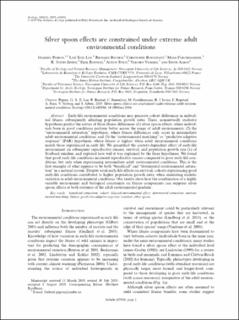| dc.contributor.author | Pigeon, Gabriel | |
| dc.contributor.author | Loe, Leif Egil | |
| dc.contributor.author | Bischof, Richard | |
| dc.contributor.author | Bonenfant, Christophe | |
| dc.contributor.author | Forchhammer, Mads C. | |
| dc.contributor.author | Irvine, R. Justin | |
| dc.contributor.author | Ropstad, Erik | |
| dc.contributor.author | Stien, Audun | |
| dc.contributor.author | Veiberg, Vebjørn | |
| dc.contributor.author | Albon, Steve | |
| dc.date.accessioned | 2020-11-26T09:50:13Z | |
| dc.date.available | 2020-11-26T09:50:13Z | |
| dc.date.created | 2019-12-04T10:47:18Z | |
| dc.date.issued | 2019 | |
| dc.identifier.issn | 0012-9658 | |
| dc.identifier.uri | https://hdl.handle.net/11250/2689709 | |
| dc.description.abstract | Early-life environmental conditions may generate cohort differences in individual fitness, subsequently affecting population growth rates. Three, nonmutually exclusive hypotheses predict the nature of these fitness differences: (1) silver spoon effects, where individuals born in good conditions perform better across the range of adult environments; (2) the “environmental saturation” hypothesis, where fitness differences only occur in intermediate adult environmental conditions; and (3) the “environmental matching” or “predictive adaptive response” (PAR) hypothesis, where fitness is highest when adult environmental conditions match those experienced in early life. We quantified the context-dependent effect of early-life environment on subsequent reproductive success, survival, and population growth rate (k) of Svalbard reindeer, and explored how well it was explained by the three hypotheses. We found that good early-life conditions increased reproductive success compared to poor early-life conditions, but only when experiencing intermediate adult environmental conditions. This is the first example of what appears to be both “beneficial” and “detrimental environmental saturation” in a natural system. Despite weak early-life effects on survival, cohorts experiencing good early-life conditions contributed to higher population growth rates, when simulating realistic variation in adult environmental conditions. Our results show how the combination of a highly variable environment and biological constraints on fitness components can suppress silver spoon effects at both extremes of the adult environmental gradient. beneficial saturation; cohort; delayed environmental effect; detrimental saturation; environmental matching; fitness; predictive adaptive response; reindeer; silver spoon. | en_US |
| dc.language.iso | eng | en_US |
| dc.rights | Attribution-NonCommercial-NoDerivatives 4.0 Internasjonal | * |
| dc.rights.uri | http://creativecommons.org/licenses/by-nc-nd/4.0/deed.no | * |
| dc.title | Silver spoon effects are constrained under extreme adult environmental conditions | en_US |
| dc.type | Peer reviewed | en_US |
| dc.type | Journal article | en_US |
| dc.description.version | publishedVersion | en_US |
| dc.subject.nsi | VDP::Zoologiske og botaniske fag: 480 | en_US |
| dc.subject.nsi | VDP::Zoology and botany: 480 | en_US |
| dc.source.volume | 100 | en_US |
| dc.source.journal | Ecology | en_US |
| dc.source.issue | 12 | en_US |
| dc.identifier.doi | 10.1002/ecy.2886 | |
| dc.identifier.cristin | 1756433 | |
| dc.relation.project | Norges forskningsråd: 267613 | en_US |
| dc.relation.project | Andre: Macaulay Development Trust | en_US |
| dc.relation.project | Andre: UK Natural Environment Research Council (GR3/1083) | en_US |
| dc.relation.project | Andre: MACAULAY DEVELOPMENT TRUST | en_US |
| dc.relation.project | Andre: UK NATURAL ENVIRONMENT RESEARCH COUNCIL (GR3/1083) | en_US |
| cristin.unitcode | 192,14,0,0 | |
| cristin.unitcode | 192,16,3,0 | |
| cristin.unitname | Miljøvitenskap og naturforvaltning | |
| cristin.unitname | Institutt for produksjonsdyrmedisin | |
| cristin.ispublished | true | |
| cristin.fulltext | original | |
| cristin.qualitycode | 2 | |

